In this article:
A blemish is a skin defect that appears in the form of a mark, spot, discoloration, patch, or other types of superficial flaws. Even though most blemishes are largely harmless, they can be particularly distressing if they develop on your face.
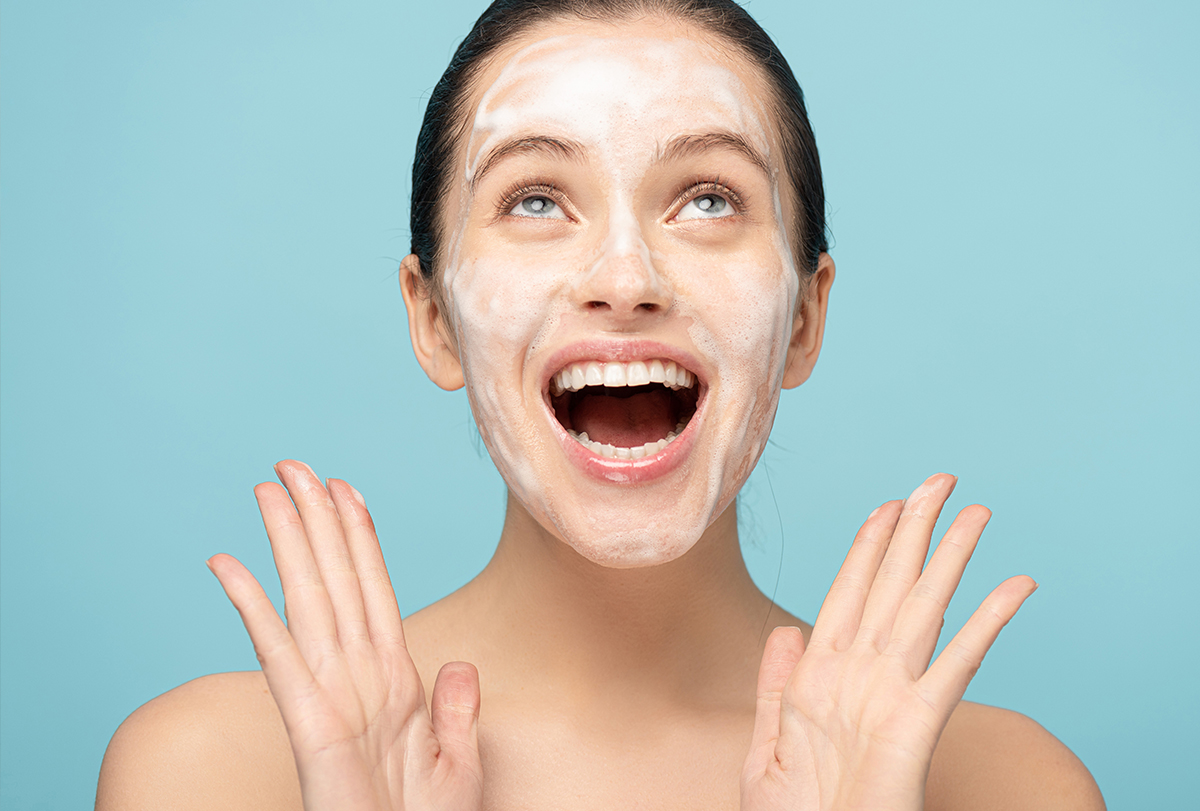
Types and Causes of Visible Blemishes
“Blemishes” is a broad term and has many types.
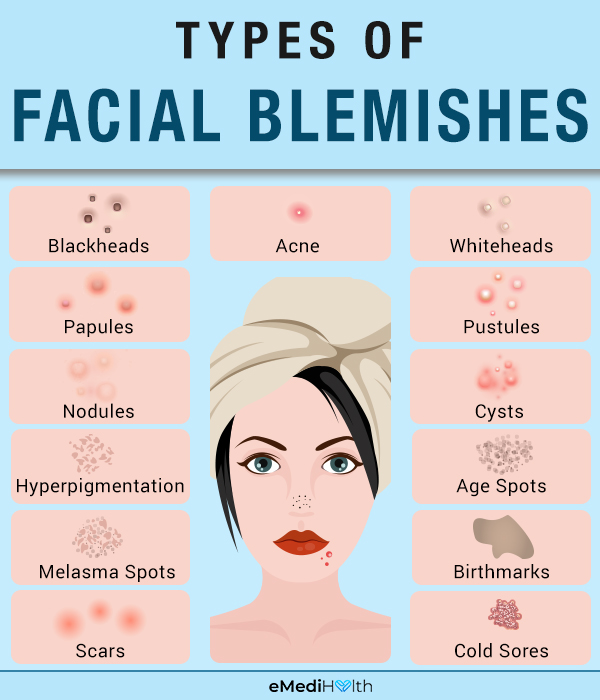
1. Acne
Your skin has several pores that are connected to an oil-producing gland. When the oil glands become overactive, they start to produce excess sebum.
Both the excessive oil and the skin cells along with the hair inside the follicle form a clumped mass that plugs the pore. This leads to bacterial overgrowth in the follicle, which triggers an inflammatory response by the body.
The following are some of the most common types of acne:
- Blackheads and whiteheads appear as small discolored bumps on the skin.
- Inflammatory or acneiform papules are small, raised, solid bumps on the skin usually less than 1 centimeter in diameter.
- Pustules are red bumps with a white or yellow center or white bumps with redness and swelling around it.
- Cystic nodules are firm, fibrous red pimples that do not contain any pus and are rooted deep within the skin.
- Cysts are similar to nodules in terms of their size, pain, and redness but have one key distinguishing feature – nodules are filled with pus.
2. Hyperpigmentation
Hyperpigmentation is characterized by the development of discolored spots or patches on your body, typically on your face.
From sun damage to hormonal changes, a number of factors can lead to the clumping of melanocytes or melanin-producing cells. Eventually, the clumping results in the occurrence of hyperpigmented or intensely pigmented patches of skin.
Hyperpigmentation is essentially a post-inflammatory skin reaction. This means it is a result of skin inflammation due to injury, burns, acne, or other causes.
3. Age spots
As you get older, your skin becomes more vulnerable to the damage caused by the sun’s UV radiation.
As your skin regeneration process becomes less efficient with increasing age, there will come a time when your skin will not be able to outgrow the sun damage, leading to the development of age spots.
4. Melasma spots
Melasma is a nonthreatening yet cosmetically distressing skin condition that is characterized by the development of dark spots on the skin. It develops primarily due to certain hormonal changes that trigger melanin overproduction.
Melasma is colloquially referred to as “the mask of pregnancy” as it is so common among childbearing women. Women who are on oral contraceptives or hormone replacement medicine are also frequent sufferers of melasma.
ALSO READ: Melasma: Causes, Symptoms, and Medical Treatment
5. Birthmarks
Birthmarks can be of different shapes, sizes, and colors but are broadly classified into two types: pigmented and vascular. Pigmented birthmarks are caused by an overgrowth of melanin-producing cells in a specific area of the skin. These birthmarks are typically black or brown.
Vascular birthmarks develop when there is an abnormal growth or malformation of blood vessels underneath the skin. These birthmarks can appear purple, pink, or red.
6. Scars
Scar formation is an essential part of the natural skin healing process. Scars usually develop on the parts of the skin that incurred a cut, burn, or laceration.
This fibrous tissue growth is your body’s way to repair the lost or damaged skin in the wake of injuries, surgeries, infections, tissue inflammation, and any skin ailment that causes blister formation. They usually develop as discolored patches that may be pale pink, brown, or silvery and can feel flat, lumpy, or sunken.
7. Cold sores
Cold sores are tiny, red, fluid-filled blisters that typically appear on the lips and around the mouth. Less commonly, these painful raised lesions may also develop on the chin, cheeks, and nose.
Cold sores are caused by the herpes simplex virus. Because cold sores are viral, they are highly contagious. They start to give off a discharge after a few days of forming and then crust over.
Common Causes of Blemishes
A number of causes are responsible for different types of blemishes.
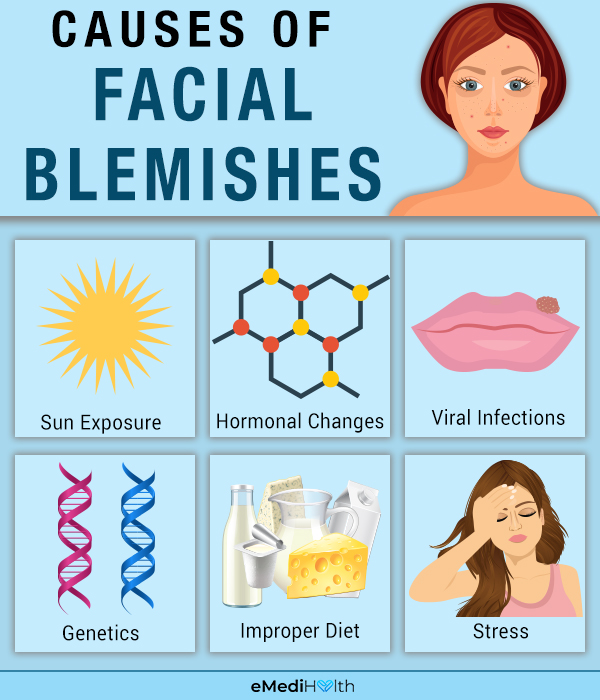
1. Sun exposure
Prolonged or frequent exposure to direct sunlight can cause considerable skin damage. When the ultraviolet (UV) rays of the sun fall on your skin, they trigger the melanin-producing cells (melanocytes) into overactivity.
Excessive production of this pigment can make your skin turn a darker shade. When some of these pigmented cells bind together to form a clump, they appear as discolored blotches on the skin. The scattered clusters of melanin take the form of freckles, moles, melasma, and age spots.
2. Hormonal changes
The scars left behind by acne lesions are one of the most common types of facial blemishes. Acne breakouts are often associated with certain hormonal fluctuations, generally abnormally high levels of androgens in the body.
Hormonal acne mostly affects the female population as they typically experience a spike in their androgen levels first during puberty and later during their monthly menstrual periods.
Women may also undergo certain hormonal changes during pregnancy and menopause that may improve or worsen their acne. It is generally reported that the use of oral contraceptives may alter female hormonal levels in a way that helps in acne clearance.
3. Viral and bacterial infections
Certain viral infections such as cold sores and chickenpox can lead to the development of skin blisters on the skin, which often leave behind blemishes. Bacterial infections such as impetigo can result in scarring, which can take time to fade.
4. Genetics
Some people scar more easily than others due to their inherited tendencies.
One review found that people with a family history of excessive scarring or those who belong to certain ethnic populations possess some genetic factors that predispose them to keloids and hypertrophic scars. (1)
5. Improper diet
Your dietary choices can also have a bearing on your skin, particularly with regard to specific types of blemishes. Excessive consumption of oily and dairy foods is commonly suspected to trigger or worsen acne flare-ups.
The intake of certain dairy products such as whole milk and low-fat skim milk is linked to an increased incidence of acne breakouts. However, other products such as cheese and yogurt are unlikely to increase your acne risk. (2)(3)
6. Stress
Heightened stress levels can undermine your skin health and your overall well-being. People who lead stressful lives or are generally in the habit of taking too much stress are susceptible to various dermatological ailments, acne in particular. (4)
Emotional stress has been identified as a prime contributor to the development and aggravation of acne by causing certain neurogenic changes in the skin. (5)
Medical Treatments for Blemishes
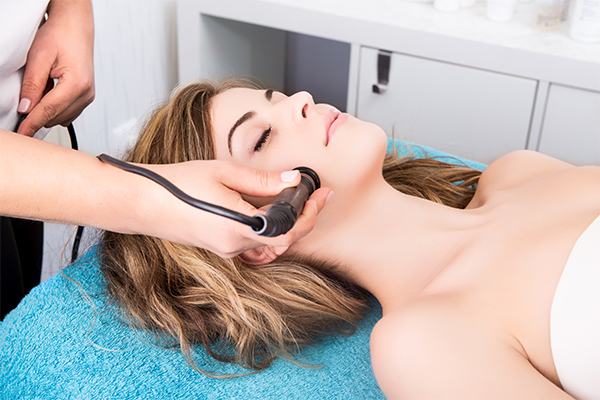
Your healthcare provider will take into account the following factors to determine the best treatment to reduce your acne scars:
- Age
- Medical history
- General health
- Severity of the scar
- Type of scar
1. Over-the-counter medications
People with relatively mild acne can try some preliminary OTC topical treatments that usually contain the following ingredients:
- Adapalene
- Retinol
- Benzoyl peroxide
- Salicylic acid
Topical ointments usually come with their own directions for use. Stick to the guidelines to avoid any undue skin irritation.
2. Prescription medications
If over-the-counter products fail to clear or control your acne, your dermatologist may prescribe something stronger to address the skin problem.
- For acne that is not too aggressive, your doctor may recommend relatively mild topical treatments such as a prescription gel or skin cream.
- However, stronger medicine such as isotretinoin may be needed for nodulocystic acne.
- For women, the oral administration of certain contraceptive pills may help reduce the severity and frequency of their acne breakouts.
3. Clinical procedures
A number of clinical procedures can be done to minimize the appearance of acne scars, which include:
- Laser resurfacing and light therapies
- Chemical peels
- Cryotherapy
- Dermal filler injections
- Injections
- Dermabrasion
When to See a Doctor
Any odd-looking discoloration, growth, or blemish on the skin needs to be medically evaluated to rule out the risk of melanoma, which is a severe type of skin cancer.
Consult a skin specialist if you develop a pigmented patch or spot that is:
- Rapidly growing in size
- Irregularly shaped
- Accompanied by redness, itching, or tenderness
- Oozing out discharge or blood
Your dermatologist will physically examine the spot. If it seems suspicious, he/she may conduct a biopsy to determine the underlying cause.
Expert Answers (Q&A)
Answered by Dr. Yolanda Holmes, MD (Dermatologist)
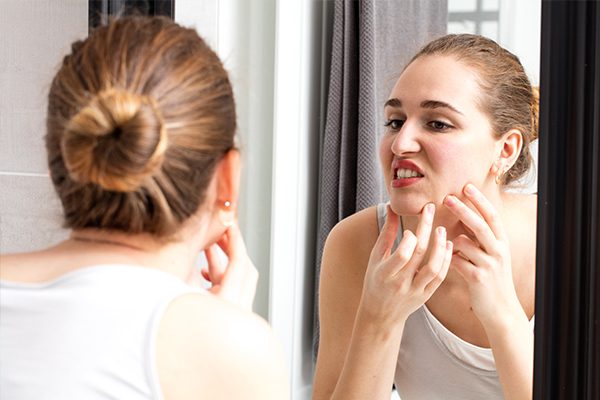
The most effective way to get rid of blemishes is to use prescription acne meds. Over-the-counter treatments such as benzoyl peroxide and salicylic acid are also very helpful.
Picking at the skin such as squeezing does make blemishes worse. Gentle touch will not hurt them.
Toothpaste and banana peel do not reduce blemishes or help them heal.
Dairy products, particularly whole milk, does cause more breakouts (blemishes).
Final Word
A facial blemish is any spot, discoloration, or mark that develops on the skin. While blemishes are generally harmless, various treatments are available to fade them if their appearance bothers you.

- Was this article helpful?
- YES, THANKS!NOT REALLY


